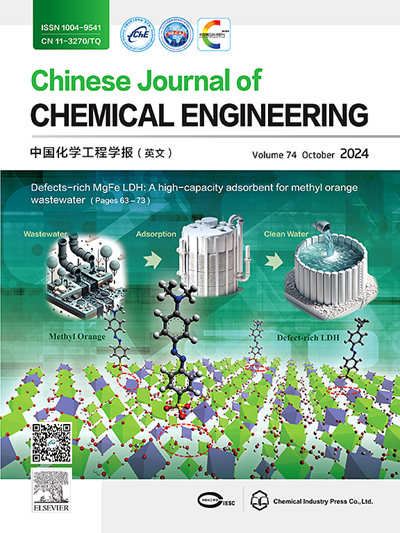Structural evolution of iron components and their action behavior on lignite combustion
IF 3.7
3区 工程技术
Q2 ENGINEERING, CHEMICAL
引用次数: 0
Abstract
Spontaneous combustion of lignite is closely related to the inherent minerals it contains, and the iron component has a remarkable influence on the combustion property of lignite. It is very important to study the influence of iron component on the combustion reaction property of lignite to reveal autoignition mechanism of lignite and reduce autoignition of lignite. In this research, FeCl3 and Fe2O3 were doped into demineralised lignite (SL+) by impregnation to research the effects of iron salts and iron oxides on the combustion properties of lignite. Based on the above, the effects of post-treatment method of the FeCl3-doped coal samples, iron-salt hydrolysis products and heat-treated temperatures on the combustion property of lignite were researched, and the microstructures of the coal samples were characterised and analysed using Fourier transform infrared spectroscopy (FTIR), Scanning electron microscope-energy dispersive spectrometer (SEM-EDS), X-ray diffraction (XRD) and X-ray photoelectron spectroscopy (XPS). The results demonstrate that doping with FeCl3 increases the combustion performance of lignite, thereby reducing the ignition temperature of lignite by approximately 112 °C. In contrast, doping with Fe2O3 has a weaker combustion-promoting effect. XRD and XPS characterisation indicates that iron species in the coal samples doped with iron salts are highly dispersed and exhibit the FeOOH structure, whereas iron species in the coal samples doped with Fe2O3 exhibit the crystal form of α-Fe2O3. Doping of lignite with FeCl3 and its hydrolysis product β-FeOOH reduces the ignition temperature of the coal samples. Iron species in the FeCl3-doped coal samples after heat treatment at 300–500 °C increase the combustion property of the coal samples, whereas iron species after heat treatment at 600–900 °C have a much weaker or non-existent promoting effect on the combustion performance of the coal samples. The characterisation show a change in iron species in the coal samples with the rise in the heat treatment temperature. This change progresses from highly dispersed β-FeOOH below 300 °C to Fe3O4 above 400 °C. Fe3O4 is gradually reduced, with part of it further reduced to elementary iron at the same time as grain growth. It is believed that the gradual agglomeration of Fe3O4 and the appearance of elementary iron are the main reasons for the weakening or disappearance of the promoting effect on coal combustion.
铁组分的结构演变及其对褐煤燃烧的作用行为
褐煤的自燃与其所含的固有矿物密切相关,其中铁成分对褐煤的燃烧性能影响显著。研究铁组分对褐煤燃烧反应性质的影响,对于揭示褐煤自燃机理,减少褐煤自燃具有重要意义。本研究通过浸渍法将FeCl3和Fe2O3掺杂到脱矿褐煤(SL+)中,研究了铁盐和氧化铁对褐煤燃烧性能的影响。在此基础上,研究了fecl3掺杂煤样后处理方式、铁盐水解产物和热处理温度对褐煤燃烧性能的影响,并利用傅里叶变换红外光谱(FTIR)、扫描电镜-能谱仪(SEM-EDS)、x射线衍射(XRD)和x射线光电子能谱(XPS)对煤样的微观结构进行了表征和分析。结果表明,FeCl3的掺杂提高了褐煤的燃烧性能,从而使褐煤的着火温度降低了约112℃。相比之下,Fe2O3掺杂的助燃效果较弱。XRD和XPS表征表明,铁盐掺杂后煤样中的铁呈高度分散的FeOOH结构,而Fe2O3掺杂后煤样中的铁呈α-Fe2O3晶体形式。褐煤中掺入FeCl3及其水解产物β-FeOOH降低了煤样的着火温度。300 ~ 500℃热处理后的fecl3掺杂煤样中的铁种类增加了煤样的燃烧性能,而600 ~ 900℃热处理后的铁种类对煤样燃烧性能的促进作用要弱得多或不存在。表征表明,随着热处理温度的升高,煤样中铁的形态发生了变化。这种变化是由300℃以下高度分散的β-FeOOH到400℃以上高度分散的Fe3O4。Fe3O4逐渐还原,部分Fe3O4在晶粒长大的同时进一步还原为初等铁。认为Fe3O4的逐渐团聚和初等铁的出现是促进煤燃烧作用减弱或消失的主要原因。
本文章由计算机程序翻译,如有差异,请以英文原文为准。
求助全文
约1分钟内获得全文
求助全文
来源期刊

Chinese Journal of Chemical Engineering
工程技术-工程:化工
CiteScore
6.60
自引率
5.30%
发文量
4309
审稿时长
31 days
期刊介绍:
The Chinese Journal of Chemical Engineering (Monthly, started in 1982) is the official journal of the Chemical Industry and Engineering Society of China and published by the Chemical Industry Press Co. Ltd. The aim of the journal is to develop the international exchange of scientific and technical information in the field of chemical engineering. It publishes original research papers that cover the major advancements and achievements in chemical engineering in China as well as some articles from overseas contributors.
The topics of journal include chemical engineering, chemical technology, biochemical engineering, energy and environmental engineering and other relevant fields. Papers are published on the basis of their relevance to theoretical research, practical application or potential uses in the industry as Research Papers, Communications, Reviews and Perspectives. Prominent domestic and overseas chemical experts and scholars have been invited to form an International Advisory Board and the Editorial Committee. It enjoys recognition among Chinese academia and industry as a reliable source of information of what is going on in chemical engineering research, both domestic and abroad.
 求助内容:
求助内容: 应助结果提醒方式:
应助结果提醒方式:


